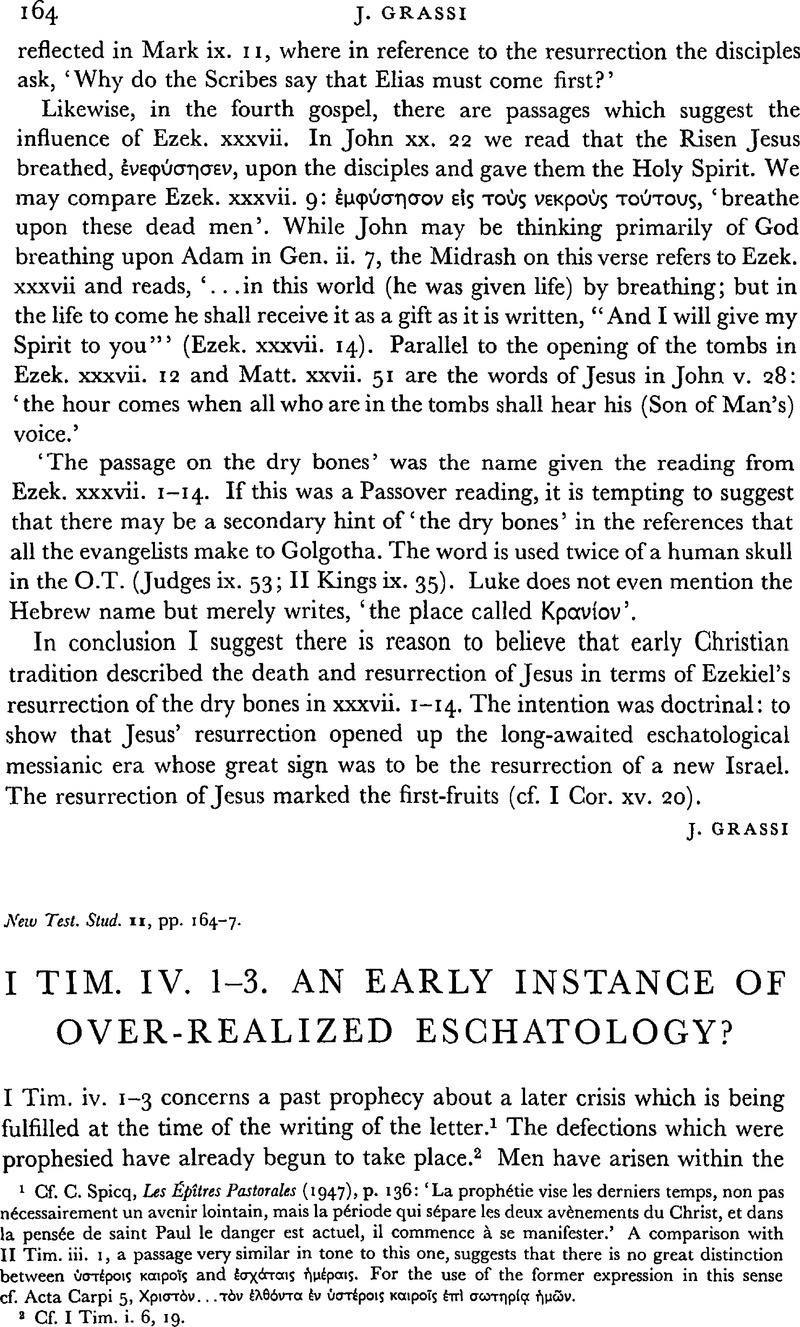Article contents
I Tim. IV. 1–3. An Early Instance of Over-Realized Eschatology?
Published online by Cambridge University Press: 05 February 2009
Abstract

Information
- Type
- Short Studies
- Information
- Copyright
- Copyright © Cambridge University Press 1965
References
page 164 note 1 Cf. Spicq, C., Les Épîtres Pastorales (1947), p. 136:Google Scholar ‘La prophétie vise les derniers temps, non pas nécessairement un avenir lointain, mais la période qui sépare les deux avènements du Christ, et dans la pensée de saint Paul le danger est actuel, ii commence à se manifester.’ A comparison with 11 Tim. iii. I, a passage very similar in tone to this one, suggests that there is no great distinction between υστέροις καıροις and έσχάταıς ήμέραıς.For the use of the former expression in this sense cf. Acta Carpi 5, χρıστον…τον έλθοντα έν υστέροıς καıροις έπι σωτηριαç ήμων.
page 164 note 2 Cf. I Tim. i. 6, 19.Google Scholar
page 165 note 1 These proscriptions, in one form or another, can be found in pagan philosophies and cultsGoogle Scholar (cf. Festugière, A. J., L'idéal religieux des Grecs et l'Évangile (1932), p. 298), as well as in Jewish fringe movements (cf. ύπεροψία γαμου of the Essenes, Jos. B.J. II. 8. 2Google ScholarPhilo, , Vita Contempl. 4). After the destruction of the Second Temple a wave of similar ascetic practices necessitated Rabbinic attention (Tos. Sota xv. II ff. (ed. Zuckermandel, p. 322); Baba Bathra 60b (Bar.)). They were common in Jewish and Gnostic Christianity of the second century. On the former cf. Iren., Adv. Haer. I. xxviii describing the Encratites, possibly with I Tim. iv. 1–3 in mind, αγαμίαν έκήρυξαν αθετουντες τήν πλασıν του θεου…καί των λεγομένων παρ' αύτοις έμψύχων είσγήσαντο αΧαρıυντες τω παντα πεποıηκοτı θεῷ; I. XXIV. 2, nubere et generare a Satana dicunt esse. Multi autem…et ab animalibus abstinent, per fictam hujusmodi continentiam seducentes multos. Cf. Acta Pauli et Theclae 12; Apost. Canon 51, 53 et al. For Gnostic Christianity see note 6 below.Google Scholar
page 165 note 2 So Spicq, op. cit. p. 137,Google Scholar ‘Ces prohibitions doivent avoir été conçues en réaction contre la débauche païenne et en fonction d'une philosophie dualiste considérant la matière comme mauvaise'; p. 355, ‘Il est bien préférable de rapprocher cette hérésie des conceptions païennes contemporaines considérant la culture intellectuelle comme une religion, une piété…’; Scott, E. F., The Pastoral Epistles (1947), pp. 138–40.Google Scholar
page 165 note 3 So Spicq, op. cit. pp. 354 f. on II Tim. ii. 18;Google ScholarLock, W., The Pastoral Epistles (1924), p. 99;Google ScholarBrown, E. W., The Pastoral Epistles (1917), p. 71,Google Scholar among others, based on Rom. vi. 1–11; Eph. ii. 6; v. 14; Col. ii. 12; iii. I. Cf. Scott, , op. cit. p. 56.Google Scholar
page 165 note 4 Cf. Iren., Adv. Haer. I, xxiii. 5,Google Scholar of the Samaritan Menander, a disciple of Simon Magus (Cf. Hadas, , Apol. I. 26);Google ScholarHippolytus, , Philosophoumena vii. 36, of Nicolas, the proselyte of Antioch; Justin, Dial. 80;Google ScholarTertullian, , de Anima 50,Google Scholar of Marcion. Minucius Felix, Octav. II, comments, ‘By a peculiar blindness they add faith to that which they have invented. You would think, to listen to them, that they were already resurrected!’
page 165 note 5 Swete, H. B., ‘The Resurrection of the Flesh’, J.T.S. XVI (1917), 135–41.Google Scholar
page 165 note 6 Some flatly denied the resurrection of the body; cf. Iren, ., Adv. Haer. xxxi.Google Scholar 2 of Simon and Carporates; Tert., De Ret. Carnis 19. A quite different explanation was that men do not rise at all, but only live on through their children: cf. Acta Pauli et Theclae 14, ηδη γέγονεν αναστασıς έφ' οıς εχομεν τέκνοıς, and the patristic citations in Lock, op. cit. p. 100. This view had Jewish precedent: cf. Sir. xi. 28; xxx. I ff.Google Scholar
page 166 note 1 Matt, . xxii. 30.Google Scholar
page 166 note 2 Luke xxiv. 42f.Google Scholar οı δε έπέδωκαν αύτω ıχθύος όπτου μέρος (+καı άπό μελıσσίου E K M N X δ θ min. latt syrc pesh philox aeg arm Justin) καı λαΒων ένωπıον αύτων εϕαγεν (+ καί τα έπίλοιπα εδωκεν αύτοīς K θ π min. c r vg syrc philox hier arm). Cf. John, xxi. 9–14; Acts x. 41.Google Scholar
page 166 note 3 Rom, . xiv. 17,Google Scholar where Βρωσις corresponds to the Βρωμα of I Tim. iv. 3.
page 166 note 4 I Tim. iv. 9.Google Scholar
page 166 note 5 Cf. II Tim. i. I; Tit. i. 2.Google Scholar
page 167 note 1 Cor. xv. 12–19; I Thess. iv. 13–18.Google Scholar
- 1
- Cited by

